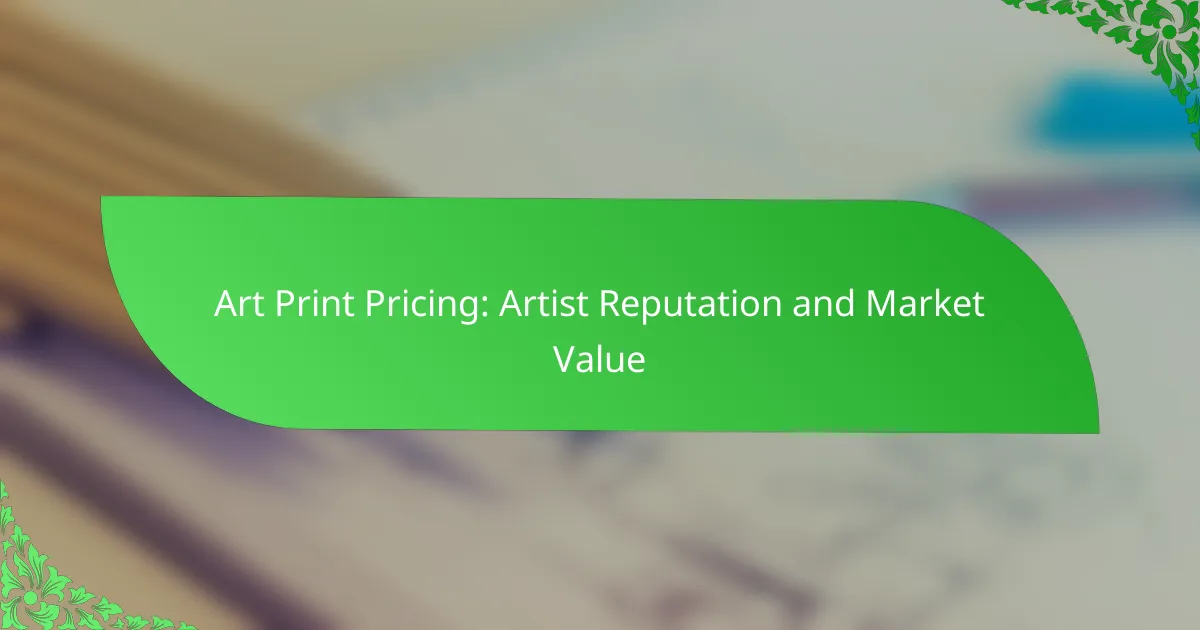Art print pricing is intricately tied to the artist’s reputation, with established figures often able to command higher prices due to their recognized status. Emerging artists, on the other hand, may offer more competitive rates as they seek to establish themselves in the market. Factors such as rarity and material quality also play crucial roles in determining market value, making it essential for both buyers and sellers to understand these dynamics.
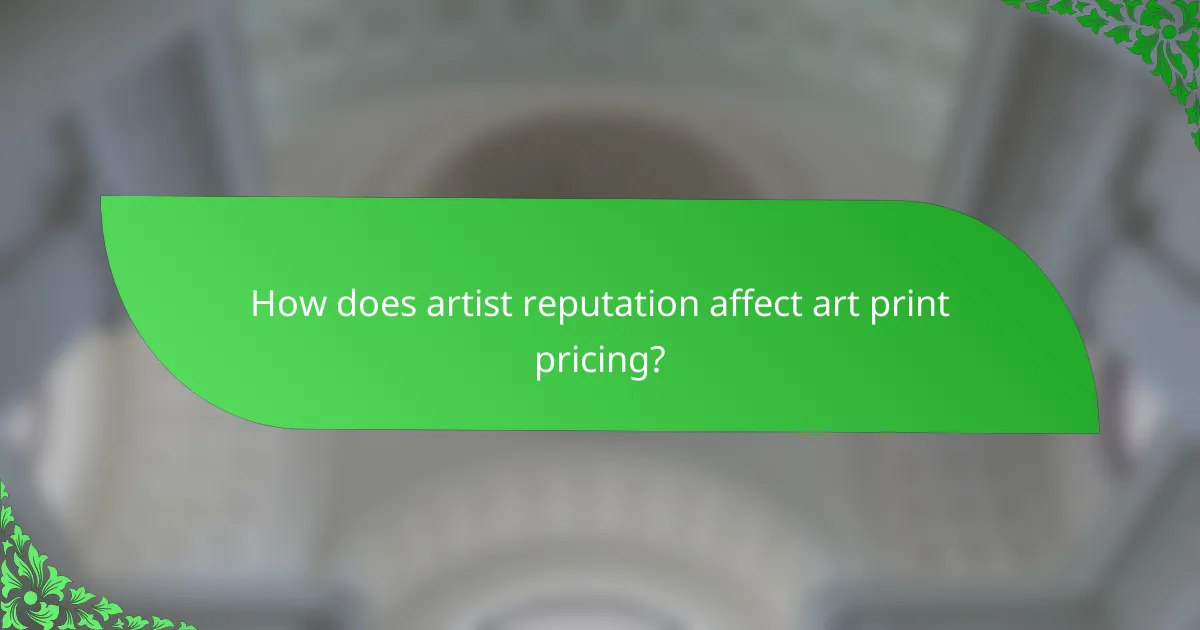
How does artist reputation affect art print pricing?
Artist reputation significantly influences the pricing of art prints, with established artists typically commanding higher prices due to their recognized status and demand. In contrast, emerging artists may offer more competitive pricing as they build their presence in the market.
Established artists command higher prices
Established artists often have a proven track record, which allows them to charge premium prices for their art prints. Their work is frequently sought after by collectors and galleries, leading to higher market values. For instance, prints from renowned artists can range from hundreds to thousands of dollars, depending on their popularity and previous sales history.
Additionally, established artists may have limited edition prints, which can further drive up prices due to scarcity. Collectors are often willing to invest more in works that are perceived as valuable and prestigious.
Emerging artists offer competitive pricing
Emerging artists typically price their art prints lower to attract buyers and gain recognition in a competitive market. This pricing strategy can range from affordable options in the low tens of dollars to mid-range prices, making their work accessible to a broader audience. As they build their reputation, these artists may gradually increase their prices.
For buyers, investing in prints from emerging artists can be a strategic move, as these works may appreciate in value over time if the artist gains recognition. Supporting new talent can also foster a vibrant art community.
Market perception influences value
The perceived value of art prints is heavily influenced by market trends, critical reviews, and the overall reputation of the artist. Factors such as exhibitions, awards, and media coverage can enhance an artist’s visibility and, consequently, the pricing of their prints. For example, an artist featured in a prominent gallery or art fair may see a significant increase in demand and pricing.
Buyers should stay informed about market trends and artist developments to make educated purchasing decisions. Engaging with art communities and following art market reports can provide insights into which artists are gaining traction and how their pricing may evolve.
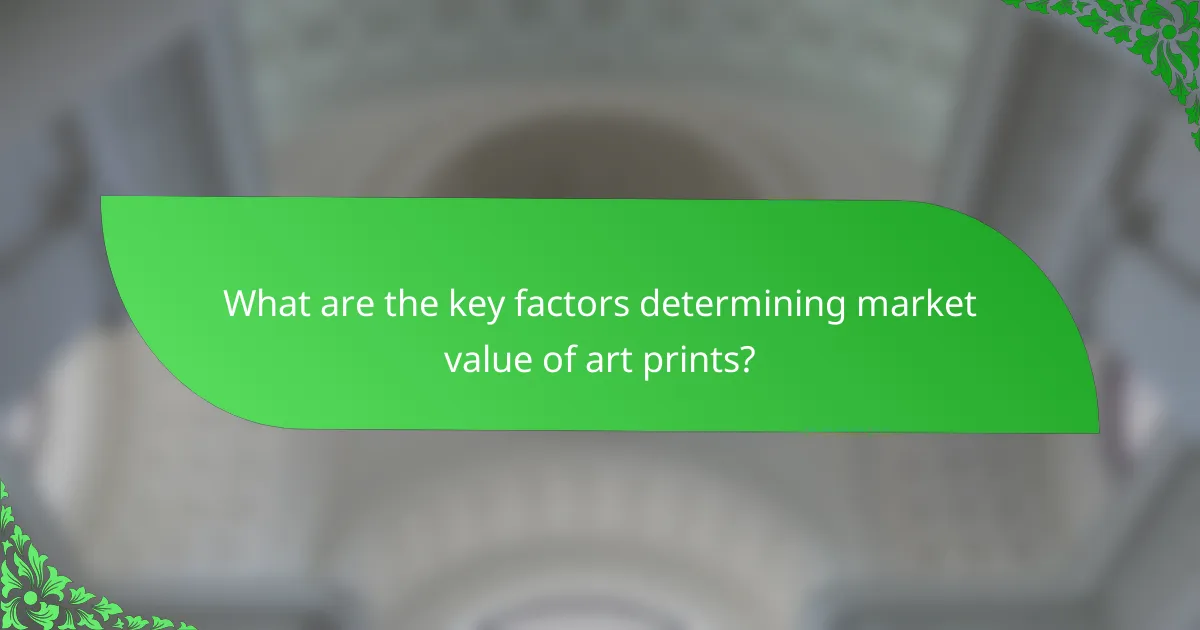
What are the key factors determining market value of art prints?
The market value of art prints is primarily influenced by factors such as the artist’s reputation, the rarity of the print, and the quality of materials used. Understanding these elements can help buyers and sellers navigate the art market more effectively.
Art print rarity increases value
The rarity of an art print significantly enhances its market value. Limited editions or unique pieces are often more sought after, as collectors value exclusivity. For instance, a print limited to 50 copies may command a higher price than one produced in the thousands.
When assessing rarity, consider how many prints were made and the artist’s overall output. A print from a well-known artist with a small body of work can be particularly valuable due to its scarcity.
Quality of materials impacts pricing
The materials used in creating an art print can greatly affect its pricing. High-quality paper, inks, and printing techniques contribute to the longevity and visual appeal of the artwork. Prints made with archival materials are often more desirable and can fetch higher prices.
For example, giclée prints, which use high-quality inkjet technology on fine art paper, are typically priced higher than standard digital prints. Buyers should look for prints that specify the type of materials used to ensure they are investing in quality.
Provenance adds to market value
Provenance, or the history of ownership of an art print, plays a crucial role in determining its market value. A well-documented provenance can enhance a print’s appeal, especially if it has been owned by notable collectors or displayed in prestigious galleries.
When purchasing art prints, inquire about the provenance to verify authenticity and understand the piece’s history. Documentation such as certificates of authenticity or gallery receipts can significantly impact the print’s value in the market.
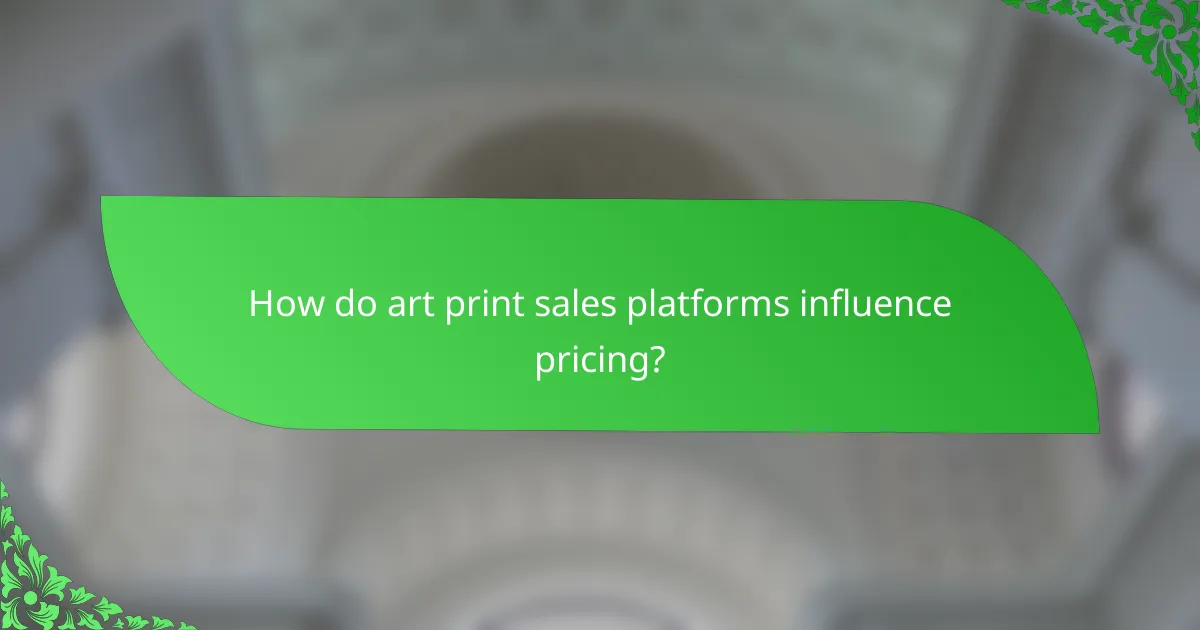
How do art print sales platforms influence pricing?
Art print sales platforms significantly impact pricing by determining the visibility and perceived value of artworks. Different platforms cater to various audiences and can either enhance or diminish an artist’s market value based on their reputation and reach.
Online marketplaces set competitive prices
Online marketplaces like Etsy or Saatchi Art foster competition among artists, leading to more competitive pricing for art prints. Artists must consider similar works’ prices on these platforms to remain attractive to potential buyers.
Prices can vary widely, often ranging from low tens of USD for prints by emerging artists to several hundred USD for established names. Artists should regularly review their pricing strategy to align with market trends and buyer expectations.
Gallery representation affects pricing
When artists are represented by galleries, their pricing often reflects the gallery’s reputation and clientele. Galleries typically take a commission, which can range from 30% to 50%, influencing how artists price their prints.
Being in a prestigious gallery can elevate an artist’s perceived value, allowing them to charge higher prices. Conversely, artists without gallery representation may need to price their works lower to attract buyers in a crowded online space.
Direct sales allow for pricing flexibility
Direct sales through personal websites or social media give artists more control over pricing. This flexibility allows them to adjust prices based on demand, promotional events, or seasonal trends without the constraints of platform fees.
Artists can experiment with pricing strategies, such as offering limited-time discounts or bundling prints for a better deal. However, they should ensure that their prices reflect the quality of their work and the effort involved in creating it to maintain credibility with buyers.
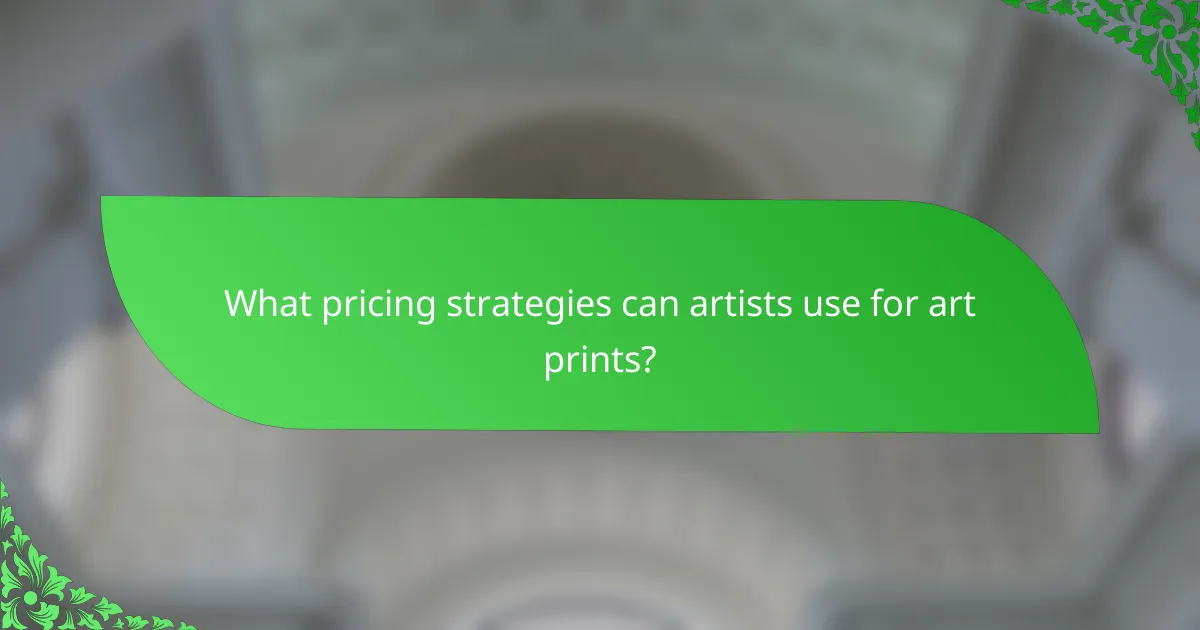
What pricing strategies can artists use for art prints?
Artists can employ various pricing strategies for art prints to maximize their revenue while appealing to different segments of the market. Key approaches include tiered pricing based on print size, creating limited editions for exclusivity, and bundling prints for value deals.
Tiered pricing based on print size
Tiered pricing involves setting different price points for art prints based on their size. Larger prints typically command higher prices due to increased production costs and perceived value. For example, a small print might sell for around $50, while a large print could range from $150 to $300.
When implementing tiered pricing, consider your target audience and the market demand for various sizes. Offering multiple size options can attract a broader customer base, allowing collectors to choose prints that fit their budget and space.
Limited editions create exclusivity
Limited editions are a powerful pricing strategy that enhances the perceived value of art prints. By producing a finite number of prints, artists can create a sense of scarcity, which often leads to higher prices. For instance, a limited run of 50 prints might sell for $200 each, while open editions could be priced significantly lower.
To effectively use limited editions, clearly communicate the number of prints available and consider signing and numbering each piece. This practice not only adds authenticity but also encourages collectors to purchase quickly before the edition sells out.
Bundling prints for value deals
Bundling prints involves offering multiple pieces together at a discounted price, which can incentivize customers to buy more. For example, an artist might sell three prints for $120 instead of $150 if purchased separately. This strategy can increase overall sales volume while providing perceived value to buyers.
When creating bundles, ensure that the prints are thematically or visually cohesive to enhance appeal. Consider offering bundles at various price points to cater to different budgets, making it easier for collectors to find options that suit their needs.
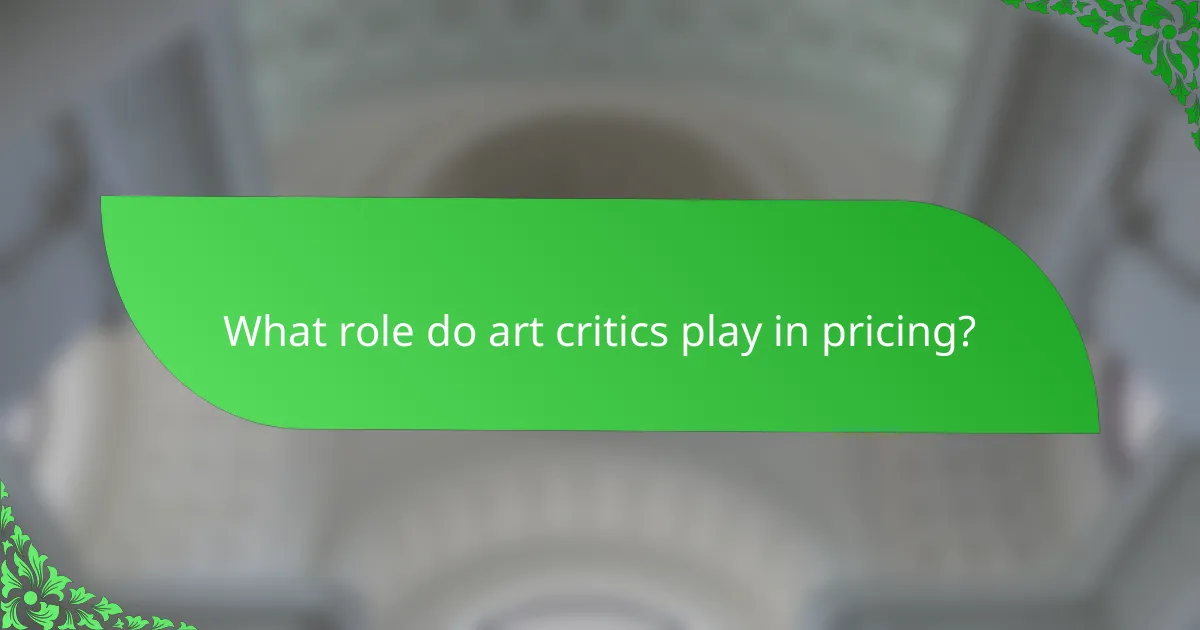
What role do art critics play in pricing?
Art critics significantly influence pricing by shaping public perception and providing valuable assessments of an artist’s work. Their reviews can enhance visibility and credibility, which often translates into higher market value for the artist’s prints.
Reviews can elevate artist visibility
Art critics’ reviews can increase an artist’s exposure, leading to greater recognition in the art community. Positive critiques often result in features in galleries, exhibitions, and online platforms, allowing the artist’s work to reach a wider audience.
For instance, a favorable review in a prominent art publication can attract collectors and buyers who may not have previously been aware of the artist. This increased visibility can create a demand for their prints, thereby influencing pricing.
Critic endorsements enhance perceived value
Endorsements from respected critics can significantly enhance the perceived value of an artist’s work. When a critic praises a specific print or collection, it can lead to a perception of higher quality and desirability among potential buyers.
For example, if a well-known critic highlights an artist’s print as a “must-have,” collectors may be willing to pay a premium price. This phenomenon underscores the importance of critical acclaim in establishing market value, often resulting in price increases that reflect the artist’s enhanced reputation.

How does regional demand affect art print pricing?
Regional demand significantly influences art print pricing by shaping what collectors are willing to pay based on local tastes and market saturation. In areas with high demand, artists can command higher prices, while in less populated regions, prices may be more competitive.
Urban areas show higher demand
Urban centers typically exhibit greater demand for art prints due to a larger population and a more vibrant art scene. Cities like New York, London, and Berlin attract art enthusiasts and collectors, driving prices up. In these markets, artists can often sell prints at premium prices, sometimes reaching hundreds or thousands of dollars.
In contrast, rural areas may have limited exposure to contemporary art trends, resulting in lower demand and pricing. Artists in these regions might need to adjust their pricing strategies to remain competitive, often selling prints at lower price points.
Local art trends influence pricing
Local art trends play a crucial role in determining art print prices. If a particular style or medium gains popularity in a region, artists working within that trend can see a significant increase in demand for their prints. For example, if abstract art becomes trendy in a city, prints in that style may sell for much higher prices compared to more traditional works.
Artists should stay informed about local trends and adjust their offerings accordingly. Engaging with local galleries, attending art fairs, and participating in community events can provide valuable insights into what styles are resonating with buyers, helping artists price their work effectively.
